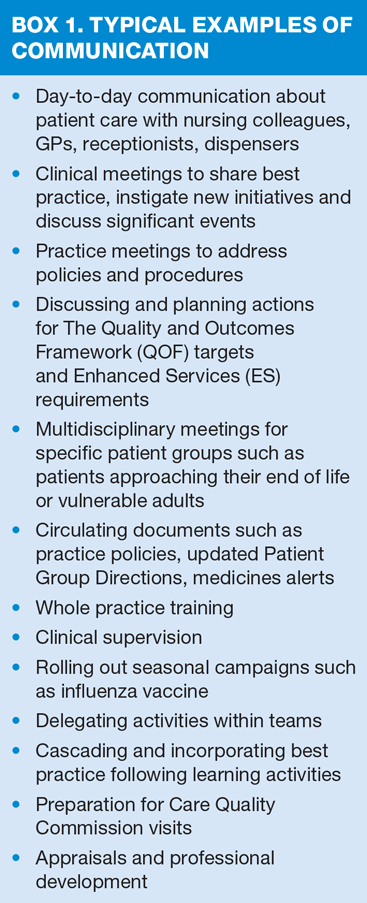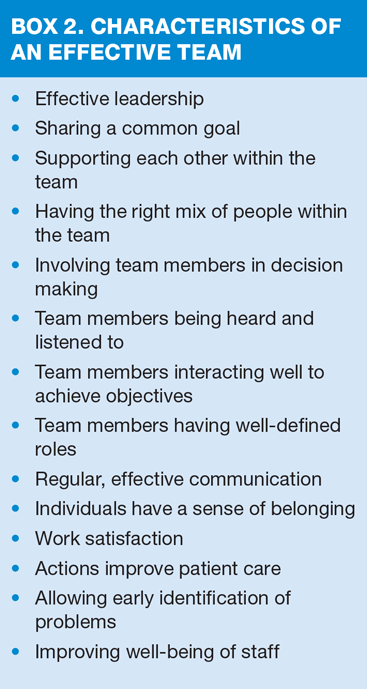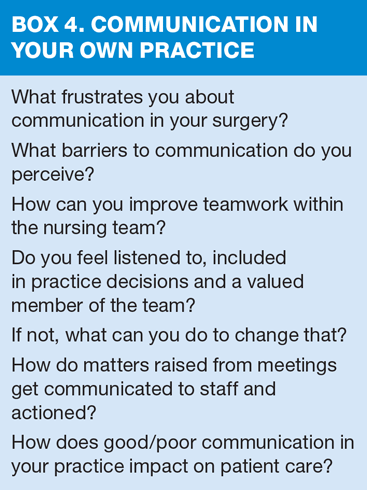Communicating with the practice team
Katherine Hunt
Katherine Hunt
RGN, RM, BSc (Hons)
Practice Nurse
Framlingham Medical Practice, Suffolk
Communication – so effective when we get it right, potentially disastrous when we don’t. We examine its importance when dealing with other members of the practice team
A typical day: before you switch on your computer you know there will be a barrage of electronic messages waiting for you to read and respond to, be they computer-generated notes, scans or emails from various members of the practice team. There may even be a series of little post-it note ‘reminders’ from colleagues on your keyboard before you even get that far.
The chances are you just have time for a cursory glance to see if there is anything that requires immediate attention but the reality is you must press on with your morning’s work. You know the messages will contain policy updates, minutes from meetings, reminders about QOF targets and matters relating to patient care. There are also likely to be external emails containing updates on clinical knowledge and practices, which you need to share with your nursing colleagues.
As you work through your morning list, you generate a number of items that need to be communicated to other members of the practice. You send an electronic message to the GP (there’s no disturbing them during surgery) about a patient who is having side-effects from their medication. You complete and fax through the requisite form to the District Nurses to arrange a weekend home visit while simultaneously speaking to the very same district nurse who has just popped back to the surgery. Later you quickly nip up to reception in between your appointments as you need to ask them to book hospital transport for your last patient. The receptionists are clearly rushed off their feet. You hover and try and catch one of them the moment an opportunity arises. On your way back to your room you remind yourself that you must have a conversation with the HCAs about nursing home visits which will need to be handled tactfully.
You might have had a chance to catch up with some of those things over lunch but you’ve got a Gold Standards Framework meeting to discuss your palliative care patients that you really need to, and want to, attend. It’s just a shame that, through lack of communication, it has clashed with the demonstration of the new ECG machine.
COMMUNICATION
Communication: so effective if we get it right; misunderstandings, resentment and repercussions if we don’t. Clearly there are many ways in which members of the practice team communicate with each other, be it face to face, or with scribbled notes, by sending and receiving computer-generated messages or more formally through minuted meetings. It depends on what it is that needs sharing, passing on or updating. How we communicate with each other at work has a direct effect on staff satisfaction, team morale, effectiveness and productivity and ultimately, on patient care.
The list of the things we communicate within the practice team really is endless (Box 1). On one hand there is day-to-day communication dealing with patient care, which might need prompt attention. Often such one-to-one conversations with other members of the team are likely to be ‘on the hoof’, catching colleagues at opportune moments. Sending electronic messages to colleagues can be effective, efficient and productive. You ask for advice, you get a response, you take action. No hanging around consulting room doors, you can get on with other work while waiting for a response and you don’t feel you’re actually disturbing anyone who might be in the middle of doing something else. But is it always so simple?
What is important is that the whole team needs to have an agreed structure to the way communication is carried out within the practice. There’s no point in having a system of sending electronic messages if they sit unactioned for several weeks. Or not being able to find a mutually convenient time with another member of staff when you really need advice as they are either in surgery, on visits, in a meeting or trying to get through their own administration without being disturbed. Or finding that you can never attend practice meetings as they are infrequent and tend to be announced with barely half a day’s notice and seemingly only attended by people who happen to be at work on that day if they can find the time.
BENEFITS AND BARRIERS
Clearly good communication between members of staff and the various practice teams is essential to the effective running of a practice in Primary Care. Effective teamwork aids performance and productivity as well as work satisfaction. Clear leadership enables more effective teamwork and results in better patient care.1 Boxes 2 and 3 highlight characteristics of both successful teamwork and ineffective communication. Barriers to communication and teamwork within the practice ultimately lead to staff feeling unsupported, creating misunderstandings, resentment and ultimately having a negative effect on patient care. The tendency to ‘crisis manage’ individual teams and situations, with no one at the helm to take responsibility within the practice, is detrimental to staff morale and productivity. Making time and looking at why communication systems don’t work within the practice will inevitably benefit everyone within the practice. However, individuals and teams all have to take on that responsibility to make it work, and be aware of each other’s roles and responsibilities. More than anything, the foundation to enable good communication to thrive within the whole practice is a unity between the GPs, to avoid contrasting and conflicting opinion, to allow everyone in the practice to work to a common goal.
IF IT’S NOT WORKING WHAT DO WE DO ABOUT IT?
Returning to the clash of lunchtime meetings between the Gold Standards Framework meeting and the demonstration of the new ECG. Firstly, you need to decide how you will manage this as a team – which staff go to which meeting, and secondly, how you can prevent ‘double bookings’ from happening in the future. Clearly both situations are important to clinical practice and inevitably the nursing team needs to have an awareness of the palliative care patients but also must be able to work an essential piece of medical equipment. Delegating the appropriate members of staff to each meeting is the best you can do under the circumstances, but equally, you need to ensure that information from both these meetings is shared amongst the nursing team as soon as is feasible. This inevitably has implications on time but it is essential. This then raises the question of how to prevent double bookings in the long term. It means looking at how meetings are booked, who makes appointments for outside speakers, trainers or representatives and how members of the team are made aware if the date or time of a meeting is changed. Thirdly, it also raises the benefit of having protected time for the whole nursing team to meet regularly to allow the team to share information, raise concerns, discuss practices, training issues and update knowledge.
MEETINGS
Team meetings within general practice can be an effective way of sharing information, keeping staff up to date and making sure everyone is ‘in the loop’ with what is going on in the practice. Clearly it would be impractical for everyone in the practice to attend every meeting. However, with good planning, sufficient prior notice, set objectives, a balance of staff from each of the practice teams attending, practice meetings contribute to ensuring all staff are kept informed. Practice meetings also provide the opportunity to share information among the whole team afterwards. It may be that the nursing team decides to rotate who attends to allow everyone an opportunity to contribute and be involved in the decision-making within the practice. Some practices may wish for all clinical staff to meet regularly. Other meetings, such as multi-disciplinary meetings, may be attended by staff with specific expertise or interest in that area and certainly team meetings for receptionists, dispensers or administration staff are usually attended by members of each specific team. Nevertheless, issues raised at such meetings are likely to have an effect on the whole practice. It is how that information is shared to the wider audience that allows staff to feel included and valued.
TECHNOLOGY
Information technology affects almost every moment of our everyday life, and no less in general practice. Information can be rapidly distributed, reaching out simultaneously to a wide audience at the click of a mouse or a simple touch of a screen. The benefits of this form of communication are undoubtedly enormous. However, is this at a cost of human interaction, personal communication and face-to-face discussion? There may be a danger that we ‘use’ electronic forms of communication to hide from face-to-face contact in situations that might cause conflict, to avoid confrontation with people rather than speaking to someone personally. Some managers may over-rely on electronic-messaging to distribute and ‘fire off’ an abundance of practice policies and the like without a thought of whether those receiving them have time to read them, or even more importantly, respond to them. A case of ‘sent it, job done’. But is that effective communication?
CONCLUSION
Those of us who have been in practice nursing long enough may remember the heady days of actually taking a coffee break, sitting with the practice team and sharing situations that arose during our morning’s work – a central hub of social activity which had far more meaning than maybe we realised at the time. These may have been informal get-togethers but what they did was allow nursing and medical colleagues to discuss issues of concern, face to face, albeit in an informal environment. Have we lost that ability to share? Is there a fear of interrupting a GP’s daily load unless we address it in a more formal meeting or via emails or electronic messages? Documentation of our actions, and leaving an audit trail, is vitally important but in essence, have we lost a togetherness, or a cohesive unit, that belonged to another time? Are we all too busy for that to happen anymore? Or has the climate of litigation and bureaucratic demands changed the way of communication in general practice?
Clearly workload and managerial expectations mean that our working day is very different in the 21st century and we have to acknowledge that and embrace the change of communication. But equally we mustn’t forget that having a well-defined structure of communication – be it on a day to day basis or by dealing with the bigger picture – is essential to the effective running of a practice, the wellbeing of its staff and ultimately to the benefit of patients.
REFERENCE
1. NHS Health Development Agency. Teamworking guide for primary healthcare. 2003 Available at: http://www.nice.org.uk/nicemedia/documents/teamworking_guide.pdf
Related articles
View all Articles



